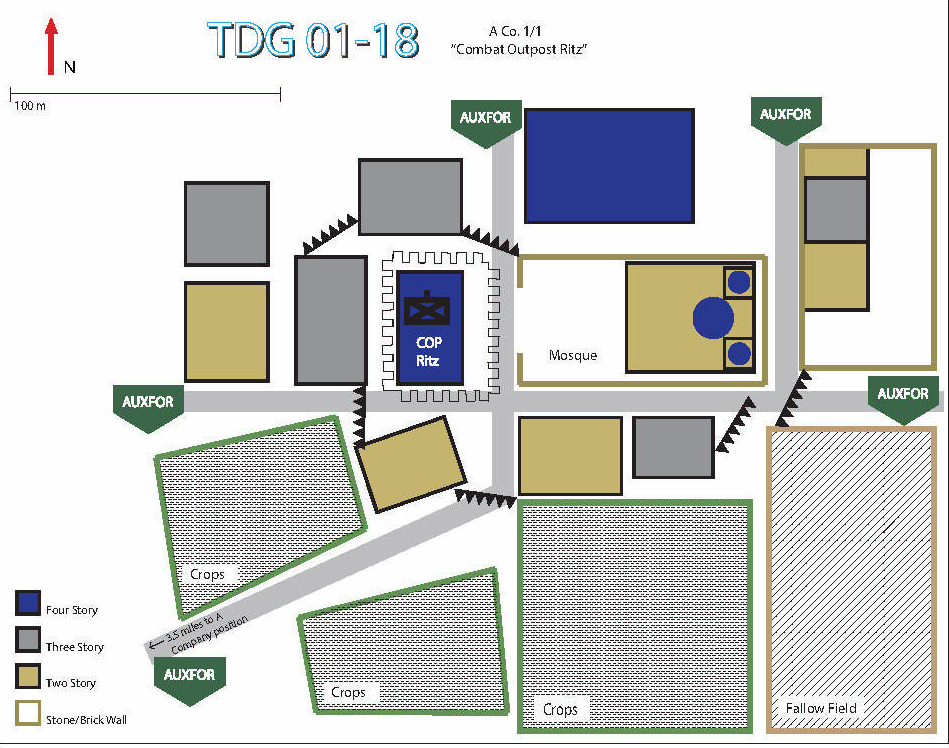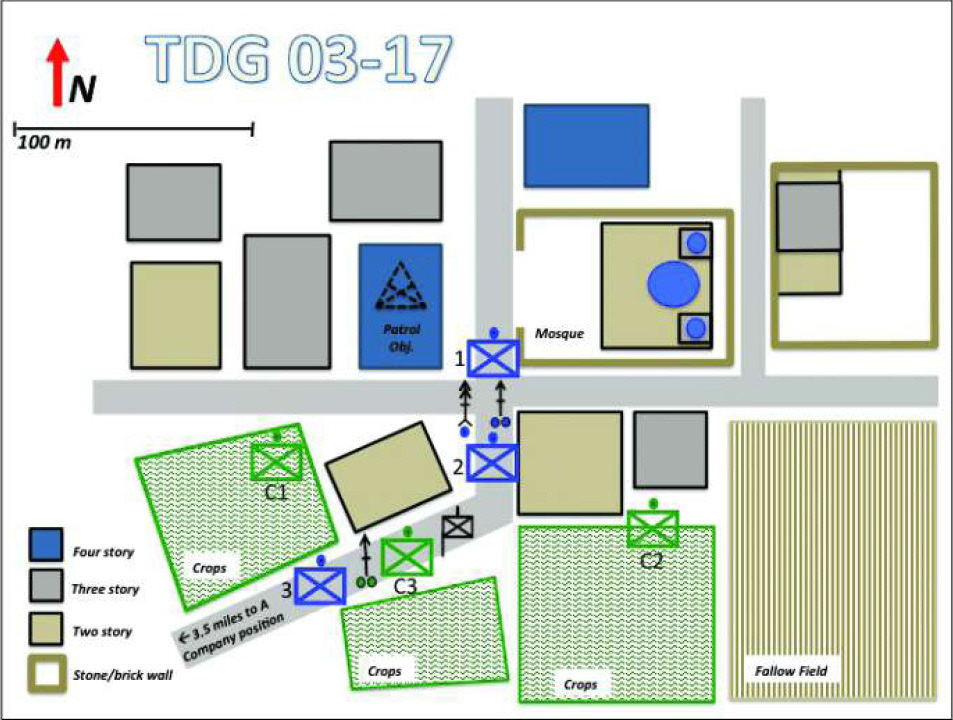Situation
 It has been 30 days since the U.S. Mission in Al Ouadiyya and the CJTF officially partnered with the Nuzuri tribe and contracted their militia as “auxiliary forces,” or AUXFOR (pronounced “oxford” by your Marines), for the security and stability mission on the island nation. You remain the Company Commander, A Company, 1st Bn, 1st Mar, and despite a non-punitive letter of caution from your battalion commander for exaggerated reporting of enemy forces in the midst of an attack on your COP (combat outpost), you are beginning to think you may stay in command of “Red Death” for the roughly two months remaining in this deployment … if you live that long.
It has been 30 days since the U.S. Mission in Al Ouadiyya and the CJTF officially partnered with the Nuzuri tribe and contracted their militia as “auxiliary forces,” or AUXFOR (pronounced “oxford” by your Marines), for the security and stability mission on the island nation. You remain the Company Commander, A Company, 1st Bn, 1st Mar, and despite a non-punitive letter of caution from your battalion commander for exaggerated reporting of enemy forces in the midst of an attack on your COP (combat outpost), you are beginning to think you may stay in command of “Red Death” for the roughly two months remaining in this deployment … if you live that long.
Your Company’s area of operations in the Al Mumeet Mosque neighborhood is still dynamic. The ubiquitous presence of Nuzuri AUXFOR patrols and checkpoints has reduced or at least forced anti-MUGA forces into the open. In other words, the enemy is more interested in attacking the “oxfords” than your Marines or the MUGA commandos attached to your company. The Nuzuri presence does nothing to demonstrate stability or rule of law in the area as groups of fighters, many as young as 12 or 13, “patrol” through this section of the city in Chinese-made pickups with crew-served weapons, and equally armed groups man random roadblocks, searching travelers and collecting a “service charge” for their work. Unlike the anti-MUGA Islamic extremists, whose preferred terror tactic was beheading, the “oxfords” employ “necklacing:” placing a car tire soaked in gasoline around the neck of a bound detainee and setting it on fire. If the captive is lucky, smoke inhalation is quick. Your Marines who have encountered the results often comment that “at least the beheadings didn’t stink so bad.” You have consistently reported these incidents, but, to date, no action has been taken or directed. You have the following forces and supporting arms available:
- 1st and 3rd Platoons, Company A 1/1: 58 effective Marines, 1 1stLt and 1 SSgt platoon commanders; 1 Hospitalman 1st Class (Independent Duty Corpsman), plus 2 Hospitalmen 3rd Class
- 2 Battalion radio operators
- 2 4-man Scout Sniper teams (2 SASR and 2 M40A5 sniper weapons)
- 1 Machine gun Section (-) (4x M240B 7.62 machine guns)
- 1 Assault Squad (2x SMAW 83mm rocket launchers)
- 1 Joint Tactical Air Controller (JTAC) Team
- 2 Interpreters (CJTF contracted)
- 1 MUGA Commando Platoon (rein): 48 Commandos total, equipped with AK-47 rifles, rifle grenades, two RPK Machine gun Sections (8x RPK 7.62 machine guns) and their own interpreters (English, Arabic, and the Nuzuri dialect)
Fire support remains limited to the battalion’s organic mortars, and Marine rotor-wing CAS on alert +15 at the battalion FOB.
The battalion’s alert +5 section of medevac helicopters has a dedicated radio net. Response time is less than 10 minutes, and the JTF Level III treatment facility is 45 minutes flight time.
Communications remain limited to unencrypted, VHF and UHF voice-only radio, wire (analog field telephones), and couriers. The local commercial telecom enterprise (landline and cellular) is also functional although unreliable and unsecure. You have sufficient radios to maintain a company tactical radio net, one battalion tactical net, and the infantry battalion mortar net. Your JTAC team also has uncovered UHF radios to coordinate RW CAS and medevacs.
Your Company has been tasked to provide security for one of the senior U.S. officials in country and a media team. Darla Hayman, a war correspondent and on-screen personality for one of the largest worldwide news networks, and her producer and cameraman are accompanying the Honorable Grainger LaSalle, Deputy Chief of Mission for the U.S. Mission in Al Ouadiyya. He has a three-man personal security detail with him. LtCol Darrin Douxe, the MEB PAO; CWO3 Yvonne Shadee, the PA Chief; and two combat camera Marines are escorting the party. The group is scheduled to RON (remain overnight) at your COP.
After issuing your orders to the company for the visit, you also instruct your platoon commanders and all NCOs to drill everyone in the COP on the current public affairs guidance from the CJTF.
The group arrives by MV-22 after your Marines secure an LZ and move to your position without incident. However, several teams of AUXFOR make themselves very visible as they overwatch the group’s arrival.
Shortly after their arrival, the MEB PA team takes Mr. LaSalle to the roof of the COP for his photo op. Ms. Hayman asks if she and her crew can “just wander around the outpost and talk to the Marines.”
After talking with your Marines for several hours, she also asks you “off the record” whether you think the Nuzuri AUXFOR are helping stabilize the country and if their support is worth $1.5 million cash the U.S. has paid to the tribal leadership and MUGA officials. Do you think the U.S.-led coalition should continue funding a regime that employs children as security forces?
Requirement A
What do you tell her? Do you continue to allow her and her team unescorted access to you Marines? If not, how do you prevent such contact?
Later that evening, LtCol Douxe shares with you that he is a Reserve officer with a lucrative career in public relations in New Orleans. Prior to leaving active duty, he was an infantry platoon commander deployed to Helmand Province, Afghanistan, in 2009. After this collegial preamble, he informs you that he will be taking the PA team on a patrol to collect footage of the Al Mumeet area. If you have any security patrols planned, he proposes combining the two patrols for added security and unity of command with him as patrol leader.
Requirement B
What do you do? Do you permit the PA team to patrol in your AO? If so, do you combine this effort into one of your security patrols or keep the patrols separate? If you combine the patrols, what mission and tasks do you assign them? How do you task organize this patrol? Who is the patrol leader: the PAO, one of your Marines, or do you make a different decision?
Instructions
Quickly formulate your plans and issue your orders. Provide a brief discussion of the rationale behind your actions. Submit your solutions by email at [email protected] or to the Marine Corps Gazette, TDG 01-18, Box 1775, Quantico, VA 22134. The Gazette will publish solutions in an upcoming issue.



